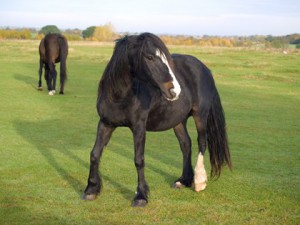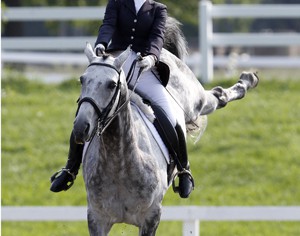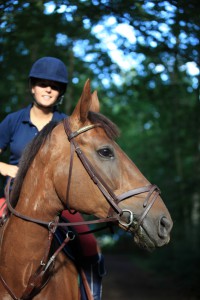 Mares are ‘seasonally polyoestrous’, meaning that they have a season in which they are confined to breeding (not all year round), and they cycle several times within this period. The typical breeding season is between May and October but some mares will cycle outside of these months. The main factor which influences the breeding season is an increase in daylight hours and artificial lighting can be used to induce oestrus. Mares will hit puberty between 12 and 18 months of age, and seasons will continue throughout their lifetime, though they often become less noticeable with age. A single oestrus cycle typically lasts for 21 days, but this varies slightly from mare to mare. Usually there are 5 days of oestrus where the mare will accept advances from a stallion, and this is when behavioural changes are noticeable- as the mare is intent on becoming pregnant, rather than listening to their handler! Behavioural problems that can often occur when your mare is in season include restlessness, and inability to concentrate, poor performance, moody and sometimes nasty behaviour and hyperactivity. How can you tell if your mare is in season?
Mares are ‘seasonally polyoestrous’, meaning that they have a season in which they are confined to breeding (not all year round), and they cycle several times within this period. The typical breeding season is between May and October but some mares will cycle outside of these months. The main factor which influences the breeding season is an increase in daylight hours and artificial lighting can be used to induce oestrus. Mares will hit puberty between 12 and 18 months of age, and seasons will continue throughout their lifetime, though they often become less noticeable with age. A single oestrus cycle typically lasts for 21 days, but this varies slightly from mare to mare. Usually there are 5 days of oestrus where the mare will accept advances from a stallion, and this is when behavioural changes are noticeable- as the mare is intent on becoming pregnant, rather than listening to their handler! Behavioural problems that can often occur when your mare is in season include restlessness, and inability to concentrate, poor performance, moody and sometimes nasty behaviour and hyperactivity. How can you tell if your mare is in season?  Sometimes it can be difficult to know if your mare is having behavioural problems due to being in season, or is just being plain naughty- if one of more of these signs are also there when she behaves badly, a supplement aimed at balancing hormones could make a significant improvement in her behaviour!
Sometimes it can be difficult to know if your mare is having behavioural problems due to being in season, or is just being plain naughty- if one of more of these signs are also there when she behaves badly, a supplement aimed at balancing hormones could make a significant improvement in her behaviour!
- Restless behaviour- the mare may pace the stable/ paddock fence
- Reduced time eating and resting
- Increased frequency of urination
- Elevation of the tail
- Clitoral winking
- Squirting of mucous and urine
- Sensitivity around the flank during girthing and grooming- pulling faces and nipping is common
- Moody and irritable behaviour!
How can a supplement help? There are various herbs available that can help to naturally address the behavioural problems mares face during their season by stabilising hormone levels and helping to reduce discomfort. For hundreds of years humans have harnessed the natural powers of these herbs to help women undergoing menopause and pre-menstrual tension Hormonease is a herbal supplement that supports normal hormone balance and behaviour. It contains a blend of herbs renowned for their positive effects on mares in season, including Chastetree berry, an organic form of dopamine, which triggers hormone control within the pituitary gland, which can help to manage oestrogen production. Naturally occurring compounds in Black Cohosh, Soya, and Red Clover Flowers ‘trick’ the body into thinking that it has produced more of certain hormones than it actually has, making the effects less extreme and keeping your horses attitude more stable. Feeding Hormonease is an effective way of controlling oestrus-related behaviour during the spring and summer, providing a natural way of balancing hormones and keeping both you and your mare safe and happy. Hormonease can also be effective on riggy geldings. How does the Oestrus cycle work?  The pituitary gland is responsible for the production of hormones that control the oestrus cycle. These hormones are follicle stimulating hormone (FSH) and lutenizing hormone (LH). When FSH is released into the bloodstream, it signals for the ovaries to develop a follicle, which contains an ovum (egg). This developing follicle produces oestrogens, which trigger a number of responses in the body, preparing the oviducts, uterus and cervix for pregnancy. This hormone produces the behavioural signs that accompany oestrus. When the estrogen level in the blood reaches a certain point, a surge of the luteinizing hormone (LH) is released into the blood supply, resulting in a number of changes to the ovum to prepare for fertilisation, and the egg is released into the oviduct. After this point the behaviour of the mare will generally return to normal, and they will not allow the stallion to mount them. Post ovulation, the cavity which is left by the expulsion of the ovum swells with blood, eventually forming the corpus luteum (also known as the yellow body). The corpus luteum produces progesterone, which influences the pituitary gland, and inhibits the release of LH. This state of Oestrus lasts for 12-14 days. Progesterone suppresses signs of oestrus, making an environment suitable for a foetus to develop in, and maintain pregnancy. If the egg is not fertilised and no pregnancy occurs, the uterus releases a substance which causes the corpus luteum to decay, and this in turn allows the next ovulation cycle to begin. By Olivia Colton MSc
The pituitary gland is responsible for the production of hormones that control the oestrus cycle. These hormones are follicle stimulating hormone (FSH) and lutenizing hormone (LH). When FSH is released into the bloodstream, it signals for the ovaries to develop a follicle, which contains an ovum (egg). This developing follicle produces oestrogens, which trigger a number of responses in the body, preparing the oviducts, uterus and cervix for pregnancy. This hormone produces the behavioural signs that accompany oestrus. When the estrogen level in the blood reaches a certain point, a surge of the luteinizing hormone (LH) is released into the blood supply, resulting in a number of changes to the ovum to prepare for fertilisation, and the egg is released into the oviduct. After this point the behaviour of the mare will generally return to normal, and they will not allow the stallion to mount them. Post ovulation, the cavity which is left by the expulsion of the ovum swells with blood, eventually forming the corpus luteum (also known as the yellow body). The corpus luteum produces progesterone, which influences the pituitary gland, and inhibits the release of LH. This state of Oestrus lasts for 12-14 days. Progesterone suppresses signs of oestrus, making an environment suitable for a foetus to develop in, and maintain pregnancy. If the egg is not fertilised and no pregnancy occurs, the uterus releases a substance which causes the corpus luteum to decay, and this in turn allows the next ovulation cycle to begin. By Olivia Colton MSc











